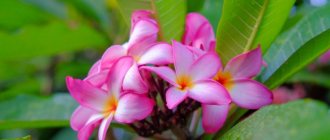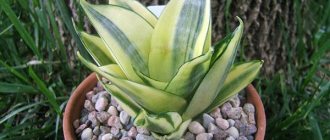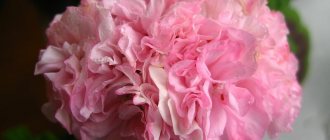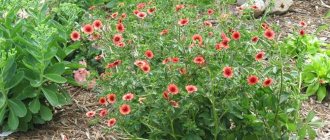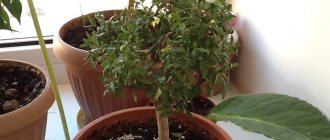Petunia is a perennial herbaceous plant that has become popular due to its beautiful, delicate and large inflorescences. During flowering there are so many of them that you can hardly see the bush behind them. Adult petunia is unpretentious in care, but its seedlings require increased attention.
Petunia is grown not only in the garden, but also as a houseplant. With proper care, it blooms even in an apartment or on a balcony. How to grow petunia in an apartment from ready-made seedlings or seeds and how to care for it - read on.
Varieties and types of petunias
Garden or hybrid petunia grows in our parks and gardens. The first terry varieties of petunias were bred in 1855, and in 1881, large-flowered ones. In the middle of the last century, the result of cell hybridization was the ampelous petunia.
Petunias can be divided into two groups based on flower size:
- large-flowered (flower diameter - 7-13 centimeters);
- multi-flowered (flowers – 5-8 centimeters).
Today, plants with small flowers (diameter - 2-4 centimeters) have become extremely popular, which form the third group - small-flowered.
Petunia is divided into the following varieties:
- bush;
- floribunda;
- calibrachoa;
- cascade;
- ampelous.
Bush petunia
Has three subspecies:
- milliflora (miniature flowers, the diameter of which is 2-4 centimeters) - Picobella Blue variety;
- multiflora (low-growing plant with flowers 5-7 centimeters in diameter) - Mirage Orchid variety;
- grandiflora (has flowers in the shape of a large gramophone).
Cascade petunia
The most popular subspecies are:
- Rose;
- Typhoon;
- Ramblin;
- Cherry.
Ampelous petunia
This species forms shoots that tend downward. The best subspecies of this variety is Surfinia. Most gardeners prefer to grow this particular variety because of the variety of colors, resistance to bad weather conditions and fast growing season.
Surfinias are divided into 3 series:
- light wave;
- pearl surf;
- waterfall.
Terry variety
This variety can be found in bush petunia (multiflora, milliflora and grandiflora). There are cases that it is found in cascade and ampelous.
Double flowers require more careful care than other varieties. These flowers are much heavier, so they cannot withstand strong gusts of wind. To plant them, it is necessary to select a protected place. It is worth highlighting the Double Cascade Mix variety.
Short description
Blooming petunia petals are familiar to many
The flower was first discovered by botanists at the end of the 18th century. However, it was only in the middle of the next century that open crops began to be subjected to selection. During the same period of time, the first hybrid varieties of flowers were developed, which were later combined into one class. They were characterized by poor resistance to frost and inability to cope with sudden changes in weather conditions. At the beginning of the 20th century, breeders managed to obtain more frost-resistant crops that can be grown not only in the house, but also outside.
Today, petunia is a medium-sized shrub that can have creeping or erect shoots. The height of the plant largely depends on the variety. However, most often the bushes grow to 50-70 cm. Sometimes there are more compact bushes no more than 20 cm high.
Petunia leaves are quite long - 50-100 mm in length. They are painted bright green. The surface of the leaf plates is covered with short fibers. The plant blooms in the second half of spring and continues to bloom until autumn. At this time, small flowers are formed on the bushes, which can have different colors. Most often, flower petals are painted in the following colors:
- purple;
- blue;
- pink;
- scarlet.
Additional Information! After flowering is completed, fruits are formed on the bushes - bivalve boxes containing seeds inside.
Breeding conditions
Beginning flower growers are often faced with the question of how to decorate their balcony with beautiful flowers? There are only two options: buy ready-made seedlings or grow planting material yourself.
Almost all varieties and hybrids of petunias reproduce through seeds. But there is also propagation by cuttings (for this method it is necessary to preserve the mother plants). Growth and flowering from cuttings occurs faster. But endurance and abundant flowering are the strengths of propagation from seeds.
Illumination of growing plants
For normal development, a young plant needs round-the-clock lighting. This technique will speed up the growth and appearance of the first buds. Petunias grown under such conditions are more resistant to disease.
Daylight hours should be at least 12 hours. The illumination level is 50,000 lux. As a rule, the lamp is turned on early in the morning, at about seven in the morning, and turned off no earlier than ten in the evening. After picking, the illumination level is increased to 55,000 lux.
For this purpose, it is best to use a special phytolamp. But a gas-charging lamp, LED or fluorescent lamp is also suitable. The distance between the lamp and the seedlings should be 20 cm.
Tulips after flowering: 6 useful tips to save the bulbs
Petunia: growing from seeds
These plants need to be sown on the surface of the soil without sprinkling them, otherwise the seeds will not germinate. Sowing is not as simple as it seems. This is due to the very small seeds. If the seeds do not fall into the seedling container, you need to use a toothpick to pick up a small seed and transfer it to the right place.
Important! It is advisable to use a second toothpick to mark the place where the seeds are sown, since they are almost impossible to see on dark soil. This method will help to sow evenly.
Using food containers will also make seeding easier. Such containers are easily ventilated, and the transparent lid can let in a sufficient amount of light rays. The use of even small-volume containers is possible before picking the sprouts.
After sowing the seeds on the surface of the soil, it is necessary to water them with water from a spray bottle. The sowing site must be covered with a plastic bag or film. They need to be ventilated periodically to avoid the accumulation of condensation, and also monitor soil moisture.
The first shoots will appear in 14-15 days (if the seeds are good, they will all appear at once). But this doesn't always happen. Many gardeners argue that if sprouts have not appeared after a 2-week period, then waiting for their further appearance is pointless. There have been cases where sprouts appeared after a month, but there will be no joy from this. These sprouts will be weak and must be constantly monitored, and the result will be unpredictable.
Selecting fertilizers
For the first two weeks, seedlings are treated with a weak solution of Pervikura potassium permanganate using a spray bottle. After the plant produces its fourth true leaf, the petunia is treated with fertilizers for foliar feeding. For this purpose, you can use Crystalon, Uniflora micro or others. Foliar feeding alternates with root feeding. Fertilizers should be applied two to three times a week.
Diving sprouts
Diving must be done with grown sprouts; for this they are seated in different containers.
Containers can be different - from small pots to plastic cups and yogurt containers.
There are secrets to growing! Petunias have a very branched and extensive root system. At home, until it gets warm outside, it will grow for about two months - this is at best.
In order to get strong and healthy seedlings, it is necessary to provide the plant with a sufficient amount of soil. In cramped conditions, the roots will not receive sufficient nutrition and no results will be seen.
Watch the video! How to sow a large number of petunias at home
There are two ways:
- instant dumping of sprouts into large containers (but this is inconvenient);
- At first, use small containers, and after 3-4 weeks, transplant into larger containers. During the entire germination period, this procedure must be carried out twice. The result will be quite strong seedlings with a very branched root system and formed buds. These seedlings will easily tolerate transplantation and quickly adapt after planting in open ground.
How to pick seedlings
Petunia seedlings dive immediately after the appearance of the first pair of true leaves, possibly even at the cotyledon stage. The main thing is to prevent stretching. Tender stems of plants break easily, so picking often seems like a very difficult task. But everything is quite simple.
Here is a photo instruction for picking petunia from a member of our portal with the nickname Nimfea.
- At this stage, you can pick into separate cups.
— You need to make a small depression in the glass.
— Select a seedling and carefully pry it with a stick.
- Always carry a seedling, holding it only by the leaf! If the leaf breaks, the stem and growing point will not be damaged.
5. Place the seedling in the hole.
6. Press the soil onto the stem with your fingers.
7. Success!
Care
Petunia loves light. At the end of winter, when sowing seedlings, it is necessary to organize additional lighting from the moment the sprouts appear. With little light, the sprouts will stretch and become too weak.
Temperature is very important. Before the first greens germinate, the temperature should be 23-25 degrees. When the first sprouts appear, the container is ventilated, thereby increasing the time the sprouts spend in the open air. A sudden change in conditions can negatively affect young seedlings.
After picking, when the seedlings have become stronger, you can continue to reduce the temperature . At night it should be about +15 degrees, and during the day - +18...+20 degrees.
You need to water carefully, without getting on the leaves. Measures when watering are also important: petunia does not like either drying out or excess moisture (rot may appear).
Like every fast-growing plant, petunia loves feeding. When planting seedlings on a mixture of soil with hydrogel, which is soaked in a solution of fertilizers, fertilizing should be done less frequently and later. Any complex flower fertilizer can be suitable for feeding.
To obtain a compact, branched and neat bush, growing shoots need to be pinched. This will not work with an ampelous variety; although it needs to be pinched, it will still grow in length. Such step-by-step cultivation will give the desired results and the seedlings can be transplanted into open ground, flower pots, and flower beds.


